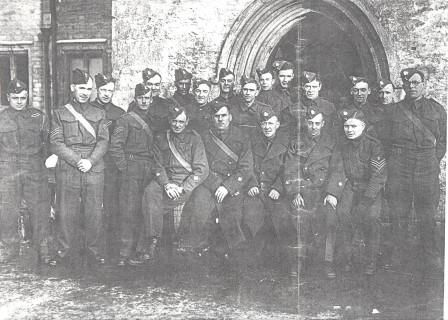WWII - Tank Crew Training
- tiana746
- Jan 3, 2024
- 4 min read
Updated: May 30, 2024

Written by Captain Ian Hammerton
Maugersbury Manor played an important role in World War II. This is the account of how Captain Ian Hammerton joined the army, was stationed at Maugersbury and trained troops to drive flail tanks, so vital in winning the war.
Ian Hammerton grew up in Dartford and attended Dartford Grammar School. He had a short career in banking before joining the Territorial Army in June 1939. He served with 43rd Battalion Royal Tank Regiment in several eastern and north-eastern counties including Northumberland on coastal defence, followed by officer cadet training at Royal Military College, Sandhurst and then served with the 61st Training Regiment at Tidworth and Barnard Castle, lecturing on the army and leading practical tank exercises. In the summer of 1943 Captain Hammerton was invited to join the 22nd Dragoons at Maugersbury Manor where he remembers his Colonel would call him Smith or Jones or anything - he couldn't accept a Royal Tank Regiment officer into his Cavalry Regiment!
Captain Hammerton’s role was to train wireless operators and gunners how to drive tanks. American troops, also based near Stow-on-the-Wold, stored bombs in “bomb dumps” along the local roads. This caused much anxiety to the trainee tank drivers for fear of colliding with them. One of Ian’s clear memories is of accompanying a trainee tank driver as he passed a troop of American soldiers. They had their mess tins lined up along the verge of the country lane and the novice tank driver inadvertently crushed the lot with the left hand track of his tank! Another fond memory is of the abundant luscious blackberries which were reachable from the turret of a Covenanter tank.
During a visit to Maugersbury Manor by Major General Percy Hobart of the 79th Armoured Division the men were informed of the necessary role of mine sweeping when they were to eventually get to N W Europe. Captain Hammerton was sent back for two weeks to his former 43rd Battalion at the secret training unit at Orford Ness. They were experimental in seeking ways to use flail tanks for mine sweeping. They experimented with a Matilda tank minus the turret and gun but with a front flail attachment. Captain Hammerton was trained in these techniques and on his return to Maugersbury he devised a system of training the squadron. His Colonel said a code name should be given to the training. At that time there was well-known Hammertons Ale and Stout so the training was coded “Stouting”!
The bulk of the training took place on the cricket field in Stow-on-the-Wold, much to the consternation of the locals. The men were trained to drive three tanks in “echelon” formation which is where the second tank follows the first with its nearside track in the mark of the offside track of the leading tank. The third tank then followed the second in the same manner. The echelon formation may also have been to the other side. The troop had to train firstly in straight lines; then learn how to negotiate corners and then learn how to drive at night using compasses. This was a difficult task as the vibration of the tank affected a gyrocompass and the close proximity of metal affected a magnetic compass! Initially the troop used Covenanter tanks but they then took possession of Sherman tanks.
The Regiment was then moved to Suffolk where the men were billeted at Rendlesham Hall, close to Orford, the tanks being transported on flatbed railway trucks. The Sherman tanks had the turret and gun and they were then also fitted with the flail attachment. This consisted of a large jib with a rotating cylinder covered in chains to the front of the vehicle. These tanks (coded Crabs) had to be driven with a good 20ft between them to allow for the flail. The Regiment worked as a team with the Assault Royal Engineers. In early 1944 they moved to Burley on Salisbury Plain which was close enough to reach Lymington for loading practice on landing craft tanks.
As Lieutenant in the 22nd Dragoons, Captain Hammerton commanded a troop of flail tanks at Juno beach in the D-Day landings on June 6th 1944, aged 22. He took part in several operations in France, including the Battle of Falaise, Le Havre, the Scheldt, Holland and Bremen. The battle in Normandy in August 1944 was crucial in closing the gap on German soldiers to open up the way to Paris and the German border. The tanks cleared a path through a minefield by slowly driving along flogging the ground ahead of them to explode the mines. To be effective, the tanks had to drive at no more than one and half miles per hour. There were 5 tanks to the troop (3 in echelon formation and 2 providing cover) and there were three regiments of flail tanks: a) the 22nd Dragoons b) the Westminster Dragoons and c) the 1stLothian and Border Yeomanry.
In 1952 Ian Hammerton married Barbara and they moved to Wilmington, Kent in 1959, where the couple still live. Together they have three children and three grandchildren. He retired in 1983 from teaching music and French and has given many talks of his war experiences. He now devotes much of his time to conservation work in Joydens Wood.
The account of Ian Hammerton’s role in the war has been condensed into this short text. However, his book “Achtung Minen – The Making of a Flail Tank Troop Commander” gives excellent detail. He has recounted his wartime memories in a fascinating interview for the Imperial War Museum http://www.iwm.org.uk/collections/item/object/80008733(Reels 2 and 3 concern Maugersbury Manor and Stow-on-the-Wold) and also been recorded by Legasee (The Veteran Video Archive) http://legasee.org.uk/the-archive/ian-hammerton.



Comments